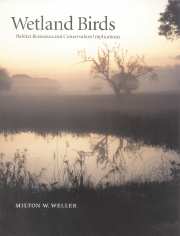Book contents
- Frontmatter
- Contents
- List of plates
- Preface
- Acknowledgments
- 1 Introduction
- 2 Wetlands: what, where, and why
- 3 Major groups of birds that use wetlands
- 4 Water and other resource influences
- 5 Foods, feeding tactics, strategies, and guilds
- 6 Bird mobility and wetland predictability
- 7 Other behavioral and physical influences on wetland living
- 8 Spatial and structural patterns
- 9 Habitat dynamics: water, plant succession, and time
- 10 Population consequences of wetland abundance and quality
- 11 How birds influence wetlands
- 12 Conservation implications
- 13 Measures of bird habitat use and quality
- 14 Current status and some conservation problems
- 15 Conservation and management strategies
- 16 Outlook
- 17 Epilogue
- Appendix 1 Scientific names of birds and bird groups
- Appendix 2 Scientific names of animals and animal groups other than birds
- Appendix 3 Scientific names of plants and plant groups
- Index of birds and bird groups
- Subject index
6 - Bird mobility and wetland predictability
Published online by Cambridge University Press: 02 October 2009
- Frontmatter
- Contents
- List of plates
- Preface
- Acknowledgments
- 1 Introduction
- 2 Wetlands: what, where, and why
- 3 Major groups of birds that use wetlands
- 4 Water and other resource influences
- 5 Foods, feeding tactics, strategies, and guilds
- 6 Bird mobility and wetland predictability
- 7 Other behavioral and physical influences on wetland living
- 8 Spatial and structural patterns
- 9 Habitat dynamics: water, plant succession, and time
- 10 Population consequences of wetland abundance and quality
- 11 How birds influence wetlands
- 12 Conservation implications
- 13 Measures of bird habitat use and quality
- 14 Current status and some conservation problems
- 15 Conservation and management strategies
- 16 Outlook
- 17 Epilogue
- Appendix 1 Scientific names of birds and bird groups
- Appendix 2 Scientific names of animals and animal groups other than birds
- Appendix 3 Scientific names of plants and plant groups
- Index of birds and bird groups
- Subject index
Summary
Various kinds of bird movement have been mentioned in relation to tracking and exploiting suitable foods and other resources, and here I want to examine the role of wetlands and their resources as forces in the evolution of long-term patterns of mobility, and their relationships to functions essential to the life cycle. There has been considerable concern recently about the requirements of terrestrial neotropical birds that favor large and contiguous habitats in migration, breeding, and wintering. In contrast, we tend to think of wetland birds as flexible users of smaller patches or “habitat-islands,” which enables a shift to seasonally better or more predictable wetlands. One should not, however, assume that any wet area they encounter is suitable. It is obvious that geographic targets for many wetland birds are quite small, and that flights over uninhabitable areas (e.g., forest, deserts, or oceans) to reach a small area may be quite perilous. It is known from banded and radio-tagged birds that birds are precise in reaching stopovers or breeding sites, even when moving from or to relatively small land masses like islands (Johnston et al. 1997), but what are the chances that the wetland “island” may be too dry – or too wet – and, therefore, uninhabitable?
We also assume that coastal birds have continuous habitat, but, while more hospitable than a forest or desert, many coastal areas are sand, gravel, or rocky cliff suitable for only a few wetland species. Unfortunately, suitable and reliable feeding, resting, nesting, or wintering areas along the coasts tend to be the same ideal habitats for humans – freshwater inflow areas that create rich estuarine wetland complexes. As a result, direct conflict with human development and recreation is inevitable.
- Type
- Chapter
- Information
- Wetland BirdsHabitat Resources and Conservation Implications, pp. 83 - 98Publisher: Cambridge University PressPrint publication year: 1999



